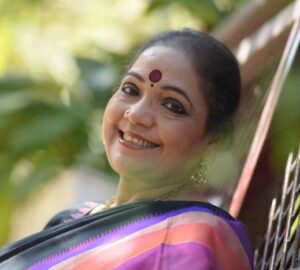The term ashtakam is derived from the Sanskrit word aṣṭā, meaning ‘eight’. In context of poetic compositions, ashtakam refers to a particular form of poetry, written in eight stanzas. The conventions associated with the ashtakam have evolved over its literary history of more than 2500 years. Adi Shankaracharya was an 8th-century Indian Vedic scholar and teacher, one of the best known ashtakam writers was Adi Sankaracharya, who created an ashtakam cycle with a group of ashtakams, arranged to address a particular deity, and designed to be read both as a collection of fully realised individual poems and as a single poetic work comprising all the individual ashtakams. He wrote more than 30 astakams in stuti [dedication] to various deities. Ashtakams were a very popular and generally accepted genre of devotional and general poetry during the golden period of Sanskrit literature, and also that of Vedic Indian Literature.

Dr Usha RK, Former Cultural Director of the Embassy of India in Moscow brought forward six beautiful Ashtakams performed in Bharatanatyam style for the art lovers in the city and the audience were enraptured by a unique dance presentation Adi Ashtakam. Usha RK is known to come up with distinctive concepts for her shows and often promotes and helps young dancers get the much desired spotlight. I chatted with her about her new presentation and how cities like Mumbai and Pune were spellbound with Adi Ashtakam.
How did the idea of Adi Ashtakam come to you?
Philosophy and spirituality is not for senior citizens only – this is the myth that many have created – it is a tool for the youth of today to achieve the unparalleled, the unimaginable, unchartered heights! We have visual images of the gods and Indic concepts in our minds that have been passed down over decades, many have evolved and some have changed though a revisiting is a must due to the passage of times and the spaces or situations we are in current times. We are facing new challenges in every aspect of our lives and not only the body but the mind and soul have to be maintained in good spirit. Chants and stotras are a great method to visualise the powers and attributes of the deity and what better than to use the medium of dance to create and understand the importance of the composition. So I decided to bring what I read on the dance floor.
Which all Ashtakams did you use and who showcased it?
I chose six dynamic Bharatnatyam dancers from all over India so that they could bring alive the Adi Ashtakam on stage for me. The visual delineation of Adi Shankracharya, saint’s eight stanza compositions were dedicated to Sharada performed by Vaidehi Rele Lal, Dakshinamurthy by Anand Sachidanandan, Panduranga by Arundhati Patwardhan, Ganga by Praachi Save Saathi, Kalabhairava by Mithun Shyam and Guru by Keerthana Ravi. The best part of this show was that these young dancers evolved through the journey of creating and choreographing their pieces. I am glad that such exercises enhance their involvement and give them a chance to delve deeper. We had live musicians supporting the dancers Kalishwaran K on Nattuvangam, Vidya Harikrishna on vocals, K Dakshinamurthy on Mrudangam, Mangala Vaidyanathan on Violin, Saraswathi ji on Veena and Selvi Pandi on Saxophone.
Why a show on Adi Ashatakams?
Adi Ashtakams are filled with many visual references and navaras in many places So, I decided to create a dance program on it, after watching this program, I wanted the audience to remember the Sanskrit poetry written by Adi Shankaracharya on Gods very visually and pictorially. I wanted to give the Indic thoughts and knowledge to people in a very simple way and what better way than dance and music.
Which part of Ashtakams attracted you the most?
One may have learned the Vedas and the six Vedangas, as well as Shastravidya, being a good poet many have written excellent poetry and treatises, but if (his) mind is not fixed on the lotus feet of the Guru, what is the use, what is the use of (these virtues) tha thah Kim? Shankaracharya expresses this feeling in his Sanskrit poems. This Guru Ashtakam of Adi Shankracharya touched me the most. And all these emotions and many more were then effectively expressed through this dance performance.
A show is incomplete without its organisers and supporters, who got you into the spotlight?
The premier show of Adi Ashtakam was held in Mumbai at Nalanda Nrityakala Mahavidhyala, where city’s dance gurus and dance enthusiast filled the auditorium, Pune show was organised by kalavardhini.co, Pune at the Bharatiya Vidya Bhavan hall under the cultural outreach program of the Infosys foundation. It was extremely special as this program marked the occasion of the 170th program of Infosys and Bharatiya Vidya bhavan’s cultural outreach program. We were thrilled that in Mumbai Dr Uma Rele, Principal Nalanda Nritya Kala Mahavidhyala and Bharatiya Vidya Bhavan’s secretary, Mr. Nandkumar Kakirde both addressed the audiences respectively.
Where all are you taking this show to?
Next few weeks we are in Bangalore and then in Delhi but here in these two cities I am adding Odissi and Kathak artists too. Talks are on, as I do wish to take Adi Ashtakam to other parts of India so that through the medium of dance and music we can spread the awareness of Adi Shankracharya’s Ashtakams. I am hoping to get support from various government and non-government cultural organisations keeping our fingers crossed.
Sandip Soparrkar holds a doctorate in world mythology folklore from Pacific University USA, an honorary doctorate in performing arts from the National American University. He is a World Book Record holder, a well-known Ballroom dancer and a Bollywood choreographer
who has been honored with three National Excellence awards, one National
Achievement Award and Dada Saheb Phalke award by the Government of India.
He can be contacted on sandipsoparrkar06@gmail.com